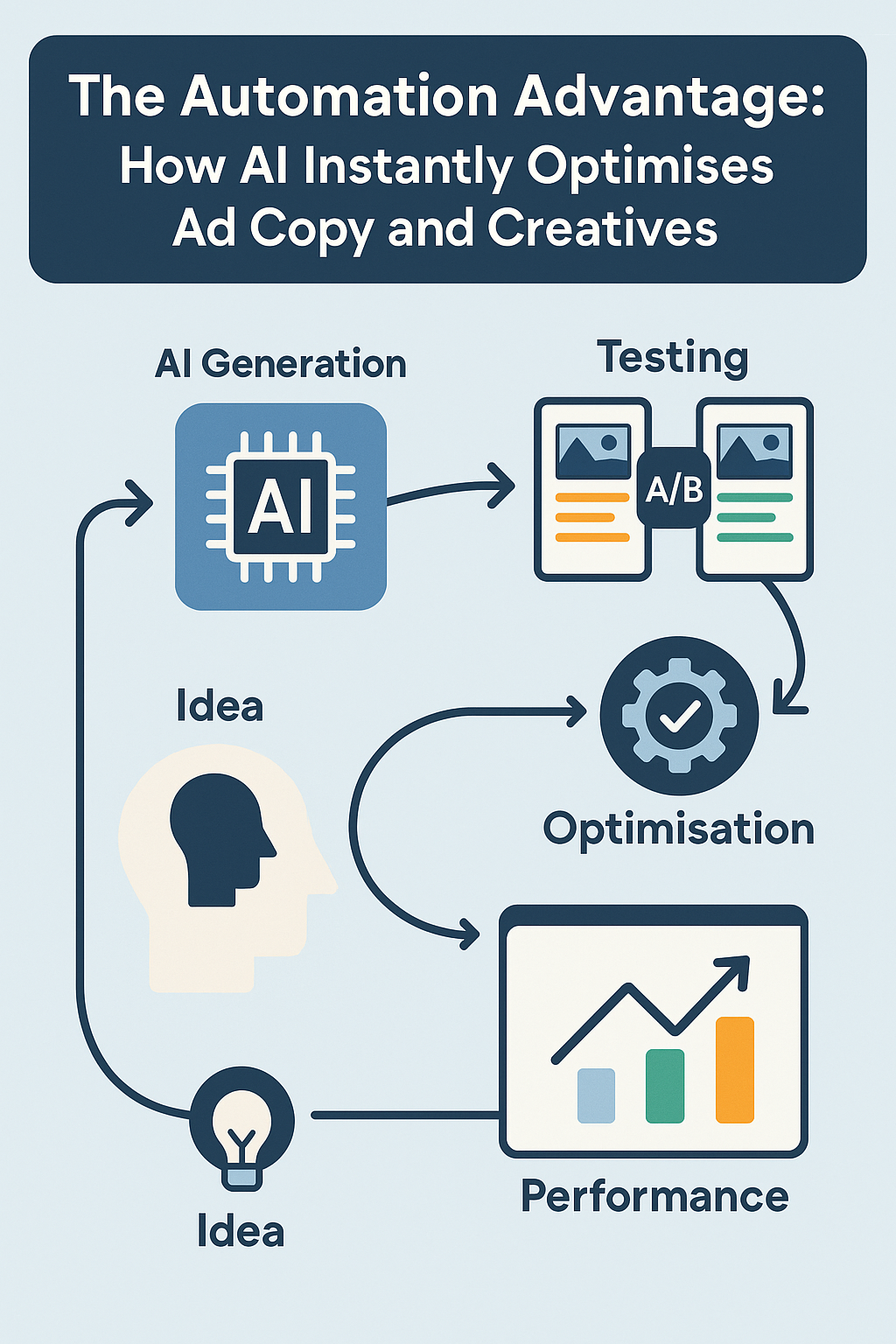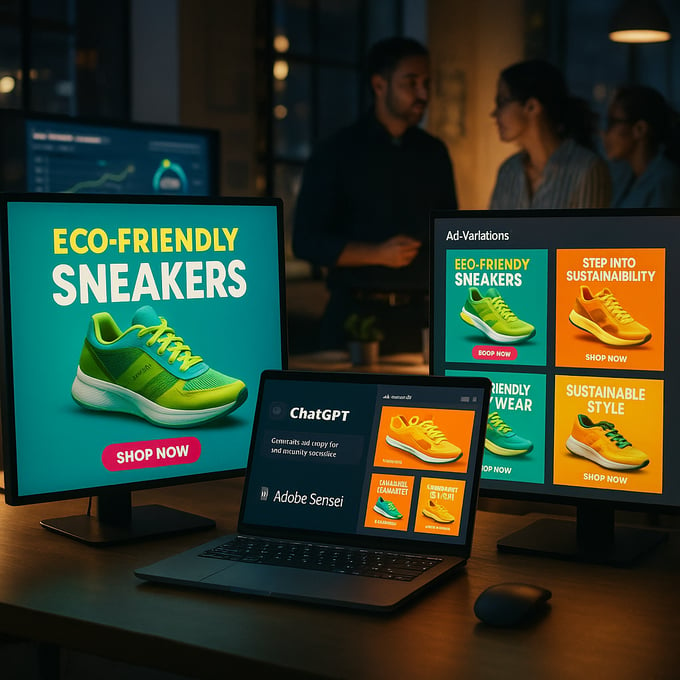In the fast-paced world of digital marketing, speed and precision determine who wins audience attention — and who gets scrolled past.
As advertising becomes increasingly data-driven, marketers are turning to AI automation tools to create, test, and optimise ad copy and visuals in real time.
What once took teams of strategists, designers, and analysts days to execute can now be achieved in minutes.
This is the automation advantage — where AI and creativity converge to deliver better-performing ads, faster.

Why Automation Matters in Modern Advertising ⚙️
The traditional advertising workflow — brainstorming, writing, designing, testing, and tweaking — is time-intensive and often drains creative teams and budgets.
Artificial Intelligence (AI) changes this completely. By combining machine learning (ML) and natural language processing (NLP), automation tools can streamline every stage of ad creation — from ideation to optimisation.
💡 Key Benefits of Automation
⚡ Speed: Generate hundreds of ad variations in seconds, not days.
🎯 Precision: Use behavioural data and predictive models to personalise every ad message.
💰 Efficiency: Cut repetitive design and writing tasks, saving on creative production costs.
📊 Optimisation: Automatically A/B test visuals and copy, continuously improving performance.
📚 Read more: AI in Advertising: A Practical Guide for Brand Managers
🧠 The future of creative success isn’t about guessing what works — it’s about testing, iterating, and learning faster than the competition.
How AI Transforms Ad Copywriting ✍️
Modern AI copywriting tools can now understand context, tone, audience intent, and platform best practices, allowing marketers to produce persuasive, brand-consistent messaging at scale.
What once took a copy team hours can now be drafted, scored, and refined by AI in minutes.
🧠 AI Techniques in Copy Optimisation
-
Natural Language Generation (NLG):
Tools like ChatGPT and Jasper.ai craft high-converting ad headlines, CTAs, and captions tailored to your tone of voice. -
Sentiment Analysis:
AI evaluates emotional tone to ensure language evokes the right response — excitement, trust, or curiosity. -
Predictive Performance Scoring:
Tools use historical data and NLP to forecast how likely a copy variation will drive engagement before launch.
✍️ Think of AI as your creative partner — it writes 100 headlines, and you select the 3 that truly resonate.
🔧 Top AI Tools for Ad Copy Optimisation
| Tool | Key Features | Ideal Use Case |
|---|---|---|
| ChatGPT (OpenAI) | Generates tailored ad copy, headlines, and CTAs in your brand’s voice. | Multi-channel ad creation and ideation. |
| Jasper.ai | Templates for Facebook, Google, and LinkedIn ads with tone control. | Paid ad campaigns and creative brainstorming. |
| Copy.ai | A/B testing variations and short-form ad copy. | High-volume ad testing. |
| Writesonic | Predicts engagement potential using real-time data. | Fast-turnaround campaigns. |
| Persado | Emotionally intelligent language optimisation. | Enterprise-level copy testing. |
📚 Further reading: Optimising for Generative AI: The Future of Digital Marketing in Australia
Creative Automation: AI in Design and Visuals 🎨
AI doesn’t just write — it designs, edits, and enhances visuals.
Creative automation tools can now generate ad layouts, banners, and videos that align with brand guidelines and automatically optimise for performance.
🎬 How AI Enhances Creative Production
🖼️ Dynamic Visual Adaptation:
Automatically resizes and reconfigures designs for multiple placements (Facebook, YouTube, LinkedIn, etc.).
🎨 Smart Design Templates:
Auto-generate on-brand visuals with consistent typography, logos, and tone — without relying on full-time designers.
📈 Performance Learning:
AI analyses which creative elements (colour, layout, imagery) drive engagement and adjusts future outputs accordingly.
💡 Result: Marketers can now produce personalised ad variations at scale — without sacrificing creativity.
🔧 Top AI Tools for Creative Automation
| Tool | What It Does | Platform Focus |
|---|---|---|
| Canva Magic Studio | AI-powered design templates, resizing, and brand-aligned visuals. | Social and display ads. |
| Adobe Sensei | Predictive analytics, smart cropping, and creative tagging. | Professional campaign assets. |
| Celtra | Dynamic creative optimisation (DCO) and automated design workflows. | Enterprise ad production. |
| AdCreative.ai | Instantly creates high-performing ad banners and visuals. | Facebook, Instagram, Google Ads. |
| Runway ML | Generates and edits short-form videos using text prompts. | Video marketing and social media. |
📚 Also read: The Rise of Short-Form Video Marketing in Australia
Dynamic Creative Optimisation (DCO): The Real-Time Advantage 🔄
Dynamic Creative Optimisation (DCO) allows brands to serve personalised ads in real-time, adapting visuals, copy, and CTAs to each viewer’s context, location, and preferences.
🧩 Example:
-
Sydney shopper searching “eco-friendly sneakers” → sees a green-themed ad with sustainability messaging.
-
Melbourne shopper → sees a “Free Delivery to VIC” variant with local imagery.
This isn’t manual targeting — it’s AI-driven personalisation at scale.
⚙️ How DCO Works
-
Integrates real-time behavioural data and audience segments.
-
Continuously runs A/B or multivariate tests across thousands of ad variations.
-
Uses machine learning to predict and deliver the best-performing creative combinations.
📊 Every impression becomes a micro-optimised experience, increasing conversions and reducing ad fatigue.
📚 Learn more: Google Dynamic Display Ads Guide
Integrating AI Tools Into Your Workflow 🧩
Implementing AI into advertising doesn’t require a total overhaul — it’s about strategic integration.
🪜 Step-by-Step Integration Framework
-
Audit Your Current Workflow:
Identify bottlenecks in creative production, testing, and reporting. -
Start Small:
Use AI tools (like ChatGPT or AdCreative.ai) for one part of your workflow — copy or visual generation. -
Set Measurable KPIs:
Track time saved, engagement lift, and conversion impact. -
Train Your Team:
Invest in upskilling to help creatives and strategists understand AI’s capabilities and limitations. -
Iterate and Scale:
Gradually connect multiple tools into one integrated AI-driven ad ecosystem.
📊 For performance measurement, see The Importance of Marketing Attribution in a Multi-Channel World.
🤝 AI enhances, not replaces, creative human strategy.
Measuring AI’s Impact on Ad Performance 📊
AI-driven advertising isn’t just about automation — it’s about measurable improvement.
To truly understand the ROI of creative automation, brands must track both creative and performance metrics that reflect efficiency, engagement, and conversion.
⚙️ Key Metrics to Track
Metric Description Creative Engagement Rate Tracks how often users interact with AI-generated ads (clicks, hovers, reactions). Higher rates indicate content relevance and resonance. Conversion Rate (CVR) Measures how effectively AI-optimised creatives inspire action — such as purchases, sign-ups, or downloads. Cost Per Click (CPC) Typically decreases as AI improves ad targeting precision and eliminates wasted impressions. Ad Fatigue Index AI tools monitor engagement dips and automatically refresh creatives before audiences tune out. Time-to-Launch Compares pre- and post-AI creative turnaround times — often reduced by 50–70%.
📈 According to IAB Australia, brands leveraging AI for ad optimisation have reported up to a 40% improvement in campaign performance, thanks to faster iteration and more accurate audience alignment.
💡 Pro Insight: The best-performing brands use AI analytics dashboards (like Meta Advantage+, Google Performance Max, or Adobe Sensei Analytics) to track these metrics in real-time, allowing constant refinement and learning.
The Future of Automated Advertising in Australia 🇦🇺
As Australian marketers move toward AI-first advertising ecosystems, automation is transitioning from a tactical tool to a strategic cornerstone.
The next phase of growth will be defined by systems that don’t just execute campaigns — they learn, optimise, and evolve autonomously.
🌟 Emerging Trends to Watch (2025–2026)
🎬 1. Generative Video Ads
AI platforms like Runway ML and Synthesia allow brands to produce personalised video ads at scale.
Imagine generating hundreds of video variations — each localised, audience-specific, and performance-tested — within minutes.
🔮 2. Predictive Audience Modelling
Using machine learning and behavioural clustering, AI predicts purchase intent and user journeys even before campaigns launch.
Platforms like Google Ads Performance Max and Meta Advantage+ already use predictive analytics to match creatives with high-intent segments automatically.
🗣️ 3. Voice-Activated Ads
As smart speakers and voice assistants like Alexa and Google Nest gain adoption, voice-based ads will create conversational brand experiences.
Example: A user asks, “What’s the best coffee near me?” and an AI-integrated ad responds with a local café recommendation, complete with a voice CTA.
⚖️ 4. Ethical AI Governance
With growing concerns around data privacy and bias, brands must adopt ethical AI frameworks — focusing on transparency, consent, and responsible automation.
Australian regulators and organisations such as the Australian Human Rights Commission (AHRC) are already setting standards for responsible AI use.
🚀 Automation isn’t the end of creativity — it’s the evolution of it.
When used responsibly, AI frees marketers from repetitive tasks so they can focus on strategy, empathy, and storytelling — the timeless heart of marketing.
🧭 Conclusion: The Automation Advantage
AI and automation are fundamentally redefining the marketing workflow.
From idea generation to campaign optimisation, what once took weeks can now happen in real-time — without sacrificing creativity.
When brands combine AI’s analytical precision with human emotional intelligence, they unlock the ability to create hyper-relevant, high-performing campaigns that respond dynamically to audience needs.
Whether managing large-scale programmatic buys or daily social ad rotations, AI-powered automation gives marketers one priceless edge:
⏱️ Time — to think, create, and connect.⚙️ The best marketers of tomorrow won’t just use AI.
They’ll collaborate with it — transforming data into empathy and automation into artistry.
🔑 Key Takeaways
✅ AI tools accelerate ad creation, testing, and optimisation.
✅ Automation enhances precision and reduces operational costs.
✅ DCO (Dynamic Creative Optimisation) enables real-time personalisation.
✅ Human creativity remains essential for emotional resonance.
✅ The future of advertising is smart, fast, and data-driven — powered by both algorithms and artistry.
Partner with Undivided Agency
The future of advertising is automated, data-driven, and human-centred — and Undivided Agency helps brands lead that future.
At Undivided, we merge AI technology with creative strategy to craft campaigns that move fast, connect deeply, and convert effectively.
💡 Whether you need smarter ad copy, automated creative production, or AI-powered personalisation — we’ve got you covered.
👉 Let’s transform your digital advertising.



.png?width=180&height=51&name=image%202%20(2).png)